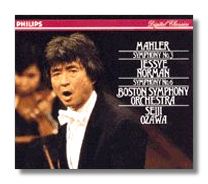
The Internet's Premier Classical Music Source
Related Links
- Mahler Reviews
- Latest Reviews
- More Reviews
-
By Composer
-
Collections
DVD & Blu-ray
Books
Concert Reviews
Articles/Interviews
Software
Audio
Search Amazon
Recommended Links
Site News
 CD Review
CD Review
Gustav Mahler

Symphonies
- Symphony #3 (1895)
- Symphony #6 "Tragic" (1904)
Jessye Norman, soprano
Boston Symphony Orchestra/Seiji Ozawa
Philips 434909-2


- Symphony #1 in D Major (1888)
London Philharmonic Orchestra/Adrian Boult
Vanguard Classics/Everest EVC9022 46.28
The Sixth Symphony, dubbed the "tragic" symphony, is one of the greatest achievements of Mahler. Large-scale, centering on one key (A minor), and intensely personal, the Sixth is a symphony unrelentingly dominated by the power of fate. Throughout the composition, life and death are at war with each other. None of the light optimism of "The Song of the Earth" shows through here, only the sense that tragedy will be forthcoming and set in a grand landscape.
Ozawa successfully directs the orchestra through its powerful, consistent movement toward crescendos, heightening the sculptural quality typical of Mahler's symphonies. The third movement (andante) starts with a sweeping, luxuriant string section followed by the continued theme held by woodwinds and sonorous French horns, later joined by trumpets, strings and the whole orchestra. The movement next led to a more subtle, resigned section, flooded by a twilit quality. Waves of sound washed over other waves around the melody line.
The concluding fourth movement (finale) sums up of the whole symphony. The ominous beginning shaded by English horns, bassoons, and bells is interrupted by fluttery strings. The horns darkly crescendo and then return to the insistent rhythm and thematic line of the first movement. All of this is accompanied by powerfully building orchestral chords and overlays between sections, leading to a climax, performed with excellent balance by the Boston Philharmonic.
The Third Symphony, perhaps Mahler's weakest, may be difficult for anyone to interpret. Its welter of themes in the first movement, at once confident and masculine, then seemingly aimless and meandering, easily demonstrate why is it so seldom performed. Mahler fails to seize the audience by the throat as he does in subsequent symphonies. Yet there are some brilliant moments in the Third and Ozawa seizes the best from them. Jessye Norman is stunning in the fourth and fifth movements.
Both live recordings are triumphs of sound, color, tension, and individual performances. My only criticism was that the orchestra sometimes lacked balance between the horns and percussive instruments (not including the drums, which were superb). In general, the orchestra played best during the tuttis, hiding individual wrong notes or flaws of shading of the individual players.
Mahler's First Symphony is a glorious one and Sir Adrian Boult, never considered a Mahler interpreter, gave a remarkable rendition a few decades back. Vanguard doesn't reveal the date of this recording, but I suspect it hails, like many Everest recordings, from the mid-Sixties. During that period Everest recorded a number of albums using three-channel stereo 35mm film masters, more than three times as wide as standard ¼" tape. Vanguard inherited these tapes and rechanneled them, using 20-bit analog-to-digital converter, which has twenty times the resolution of standard 16-bit signals. The result is a remarkable room-sized sound that you'd swear was digital to start with.
The recording itself is magnificent and ranks just below Bernstein's interpretation. Boult is fond of large raucous sound, as can be heard in his many renditions of The Planets (which he premièred in 1918). He misses no opportunities to express a particularly passionate outburst, such as the stormy final movement. Yet he manages to pull off the theatrics with balance and subtlety, admirably complementing the preceding lyrical movements (particularly the melodic first). Despite a few twinges of British bathos in the middle, this rare and odd recording should be a boon to any serious Mahler listener.
Copyright © 1996, Peter Bates


















